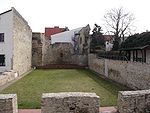Flavian Palace

The Flavian Palace, normally known as the Domus Flavia, is part of the vast Palace of Domitian on the Palatine Hill in Rome. It was completed in 92 AD by Emperor Titus Flavius Domitianus, and attributed to his master architect, Rabirius.The term Domus Flavia is a modern name for the northwestern section of the Palace where the bulk of the large "public" rooms for official business, entertaining and ceremony are concentrated. Domitian was the last of the Flavian dynasty, but the palace continued to be used by emperors with small modifications until the end of the empire. It is connected to the domestic wing to the southeast, the Domus Augustana, a name which in antiquity may have applied to the whole of the palace.
Excerpt from the Wikipedia article Flavian Palace (License: CC BY-SA 3.0, Authors, Images).Flavian Palace
Criptoportico Neroniano, Rome Municipio Roma I
Geographical coordinates (GPS) Address External links Nearby Places Show on map
Geographical coordinates (GPS)
| Latitude | Longitude |
|---|---|
| N 41.888611111111 ° | E 12.486666666667 ° |
Address
Domus Flavia
Criptoportico Neroniano
00184 Rome, Municipio Roma I
Lazio, Italy
Open on Google Maps








